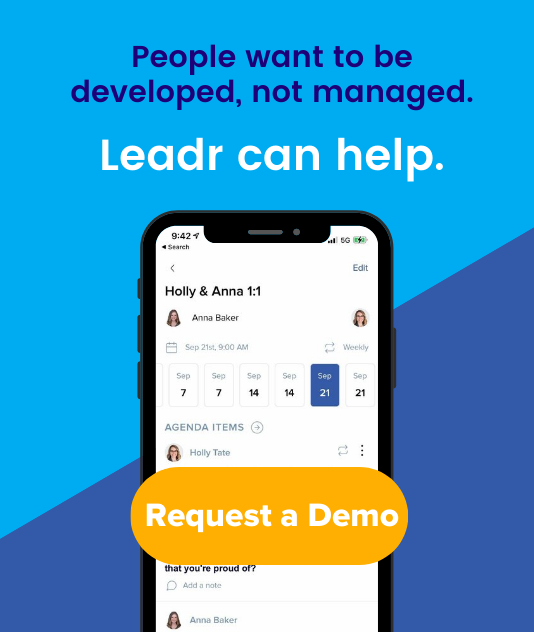The Power of Public Accountability: Patrick Lencioni’s Insights and How Leadr Advantage Drives Transparency
Last year, the Leadr executive team participated in a transformative training on Patrick Lencioni’s The Five Dysfunctions of a Team. The two-day experience was nothing short of an eye-opener, shedding light on how we could improve our team’s health, unity, and overall effectiveness.
For any leader looking to strengthen their team, Lencioni’s book is a must-read—and the insights from his training were game-changing for our leadership team.
One of the most impactful lessons we learned during this session was this: tough conversations should happen publicly. This principle challenged everything we had previously been taught about leadership.
For years, we had heard the common advice, “Praise in public, correct in private.” Yet, as we practiced public accountability within our executive team, something remarkable began to unfold.
Here’s how this approach to leadership helped us eliminate silos, create clarity, and build stronger trust—and how Leadr Advantage can help other organizations foster the same results.
Breaking Down Silos: Transparency is Key
The first dramatic shift we experienced after embracing public accountability was the elimination of silos within our leadership team.
Prior to this, each department functioned somewhat independently, and there were invisible walls separating what was happening in each area of the company. When we began openly discussing challenges, decisions, and performance issues in our team meetings, it created a shared understanding of what everyone was working on and how it contributed to the larger mission.
Suddenly, team members who had previously kept to their own areas of expertise began collaborating in ways we hadn’t anticipated. When silos are broken down, you allow for more creative problem-solving and cross-departmental collaboration. No one is left out of the conversation, and the entire organization begins to move forward with greater alignment.
Creating Clarity: Expectations Set in the Open
Public accountability also brought clarity to our decision-making process. One of the key examples of this came from our CFO, Brett. Initially, Brett didn’t feel the need to contribute to discussions outside of the Finance department. It’s easy for anyone in a specialized role to think, "This doesn’t apply to me, so I’ll stay out of it." We, too, have been guilty of this mindset in the past, deferring to others when they have more expertise in certain areas.
But we quickly realized that if we wanted to make unified decisions, everyone had to participate, regardless of their department. As a leadership team, it was important for us to set the expectation that everyone’s voice matters in every conversation—especially at the executive level, where alignment and clarity are critical to driving success throughout the organization. When we make expectations public, it becomes clear that every team member’s input is valued.
This kind of transparency allowed us to cut through any confusion or uncertainty. It helped us make quicker, more informed decisions and ensured we were all moving in the same direction.
Resolving Conflict Faster: Tackling Issues Head-On
It might sound counterintuitive, but one of the most unexpected benefits of public accountability was the way it helped us resolve conflicts faster. Instead of letting issues linger or sweeping problems under the rug, we started addressing them in real-time during team meetings. It wasn’t always comfortable, but it was incredibly effective.
By tackling issues publicly, we built a stronger sense of trust within the team. We weren’t avoiding difficult conversations; we were embracing them. This approach minimized the need for follow-up one-on-one meetings where we used to have to address issues privately. Now, we could solve problems collectively and ensure everyone was on the same page immediately.
Yes, public accountability can be awkward at times. But, as Pat Lencioni has taught, the trust and clarity that emerge from open discussions far outweigh the discomfort of those moments. And over time, the team began to express that their trust in one another had grown exponentially. This type of open feedback loop has helped us become better problem-solvers and has strengthened our collaborative efforts.
How Leadr Advantage Supports Public Accountability and Team Health
As we continue to practice public accountability within our leadership team, the positive results have been undeniable. But creating a culture of transparency and trust doesn’t happen overnight—it requires consistency and the right tools to support it. This is where Leadr Advantage can help.
The Leadr Advantage software is designed to foster transparency, accountability, and alignment across teams. Through features like performance tracking, feedback loops, and goal alignment, Leadr Advantage helps leaders:
- Facilitate Open Communication: Leadr Advantage’s tools allow teams to have ongoing conversations about performance, challenges, and wins in real-time. It’s easy to set expectations, track progress, and address issues collectively.
- Build Trust Through Feedback: Public feedback doesn’t need to be uncomfortable when it’s part of a consistent, structured process. Leadr Advantage helps teams create a culture where feedback is seen as a tool for growth rather than criticism.
- Increase Clarity and Alignment: With the Leadr Advantage goal-setting and tracking tools, everyone in the organization can stay aligned around common objectives, eliminating confusion and making it easier to achieve team goals together.
Public accountability doesn’t just create better leaders—it creates better teams. By fostering a culture of transparency and open communication, Leadr Advantage helps organizations ensure that everyone’s voice is heard, silos are broken down, and conflicts are resolved quickly and constructively.
The Challenge of Public Accountability
If the idea of public accountability feels intimidating, you’re not alone. It’s a difficult shift for many leaders. But embracing this approach can transform how your team works together. When leaders set the example of handling tough conversations openly, it paves the way for a more collaborative and high-trust environment.
If you're unsure about how to begin practicing public accountability in your own leadership team, we encourage you to give it a try. Take that first step and start setting the expectation that tough conversations will be handled in the open. You may feel some initial discomfort, but the results will be worth it.
For more insights into how to implement public accountability and strengthen team health, listen to this episode of the LeadrPulse Podcast, where Patrick Lencioni shares even more on this topic.
Share this
You May Also Like
These Related Stories

Navigating Politics in the Workplace: Apply Patrick Lencioni’s Insights With Leadr Advantage

From Wonder to Tenacity: Embracing Patrick Lencioni’s 6 Working Geniuses for Effective Work





No Comments Yet
Let us know what you think